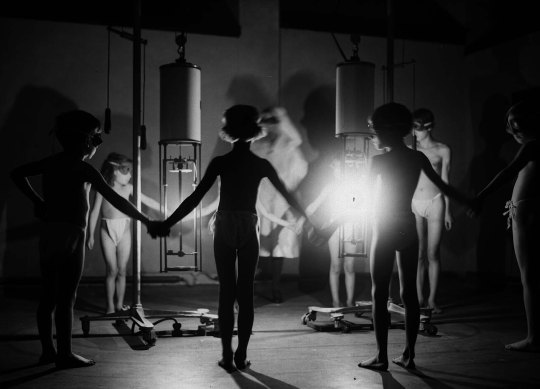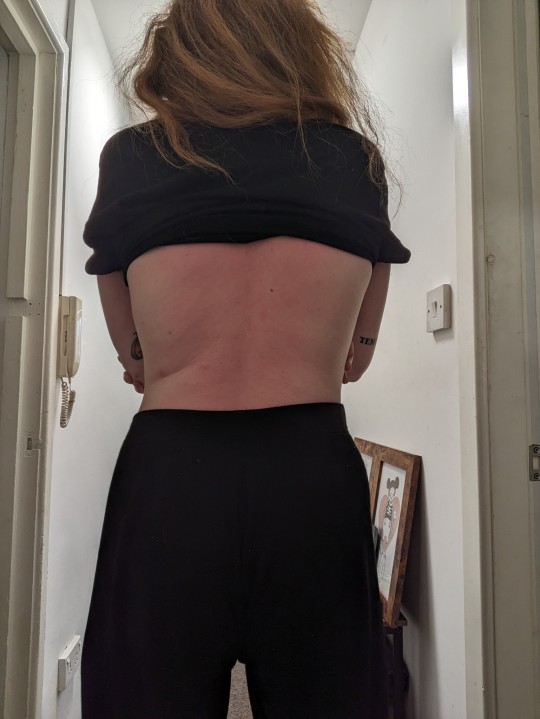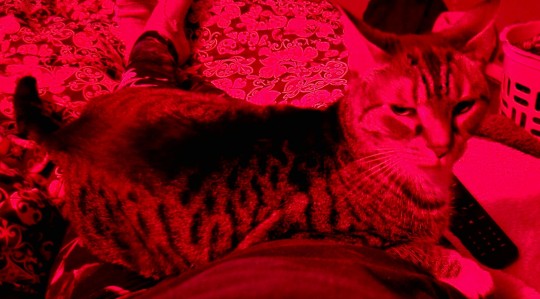#light therapy
Text
Stimulating a key part of the brain using light helps Alzheimer's patients sleep better and improves their psycho-behavioral symptoms, according to a review of studies involving nearly 600 people with the disease.
Based on the minimal side effects observed, the research team from China's Weifang Medical University suggests this could be a viable, non-drug treatment option.
The team conducted a meta-analysis of 15 trials testing how light therapy, or photobiomodulation (PBM), impacts symptoms of cognitive decline.
Continue Reading.
100 notes
·
View notes
Text

My mom got me a light that mocks the sun that helps improve mental health. It lights my whole room and I’m purely obsessed with it. I now have good enough lighting to read in bed!
#personal#hipster#hippie#boho#good vibes#hippie vibes#bohemian#happy#peaceful#peace#it’s all good#aesthetic#ootd#long hair#wavy hair#brandy melville#boho room#light therapy
87 notes
·
View notes
Text

A group of children hold hands around a radiating glow of ultraviolet light at the [Institute of Ray Therapy, Camden], undated (c. 1930).
As cited in Soaking Up the Rays: Light Therapy and Visual Culture in Britain, c. 1890–1940.
80 notes
·
View notes
Text
All light generates electrical signals in the retina at the back of your eye and in the cortex region of your brain.
Red and blue lights generate the largest signals. Green light generates the smallest signals. This is probably why it’s less likely to bother people with photophobia. For some people, migraine symptoms may even improve.
Green light therapy is more than just a green light bulb or a green glow. Instead, it involves a specific, narrow band of green light from a special lamp. You have to spend time in this green light while filtering out all other light.
But what is really known about green light therapy? Is it a viable option for easing the intensity of migraine attacks?
What does the research say?
Many people with migraine experience photophobia, which can exacerbate pain.
A 2016 studyTrusted Source found that green light is significantly less likely to exacerbate migraine attacks than white, blue, amber, or red. Almost 80 percent of study participants reported intensified symptoms with every color except green, which only affected half as many. Twenty percent of participants reported that green light reduced migraine pain.
The researchers suggest that at low intensities and filtering out all other light, green light may lessen the intensity of photophobia and migraine pain.
A 2017 study involved three groups of rats with neuropathic pain.
One group was bathed in green light from LED strips. A second group was exposed to room light and contact lenses allowing the green spectrum wavelength to pass through. A third group had opaque contact lenses that blocked green light.
Both groups exposed to green light benefited, with effects lasting 4 days from the last exposure. The group that was deprived of green light saw no benefit. No side effects were observed.
It’s thought that green light may increase certain pain-relieving chemicals in the brain.
A small, randomized, clinical trial is currently being carried out that focuses on fibromyalgia and migraine pain. Participants will use an LED green light strip at home every day for 10 weeks. Then their level of pain, use of pain relievers, and quality of life will be assessed. {read}
16 notes
·
View notes
Text

So I'm getting a sun lamp
#sun lamp#light therapy#cuz the days are shortening FAST#me; this lamp might want to work#going to photosynthesize myself everyday to keep the SAD away#plant moment#lowkey excited too cuz i've heard great things about them#i'll keep you guys updated to see how it works for me; if it works I'll give you the brand and model; since the one I'm getting is $19 CAD#SAD is like a vampire; you kill it with sunlight
13 notes
·
View notes
Text
Sitting in front of my SAD lamp for my stupid mental health. Whyyyyyy is it so hard to sit in one place for an hour?
#text post#seasonal depression#light therapy#i dont feel like i have the 'hyperactivity' pard of adhd#until i have to sit in one place for an hour#at least amara is keeping me company#tony is trying to annoy me into getting up and feeding cats#he also tried to push my lamp off the table
9 notes
·
View notes
Text
For anyone else with chronic fatigue, can I suggest trying out a sun lamp?
I've had one for a few weeks now and it helps me a bit. The impact is minimal (I'm a little less tired for up to a couple of hours after using it), but it's still something and it's the only treatment I've found so far that does anything at all. I'm sure it won't help everyone, but the lamps are inexpensive and can be used passively. I got mine for only $18 [link] and it has a long return window.
I'm still very new to navigating life with chronic fatigue (as part of long covid), so I'd love to hear from other people on any effective treatments they've found.
#idk if this is common advice#hopefully this can help someone else#PLEASE don't expect the light to work miracles#it really does have quite a minimal impact#Like I'm usually 1% to 5% less tired for like 30 minutes to a few hours after using it#Some days it doesn't really do anything#cfs#cfs (chronic fatigue syndrome)#chronic fatigue#long covid#covid#sun lamp#light therapy#chronic illness#spoonies#spoonie#mine#seeking help
43 notes
·
View notes
Text
#laser #koreanfacialtreatment #avainseoul #facialtreatment #lasertreatment #LaserClinics #BBLTherapy #BroadBandLight #BBL #CollagenBoost #SkinCare
3 notes
·
View notes
Text
Went for my first phototherapy / light therapy today. Is this normal? 😅 I am very very fair, also on meds that make me more photosensitive, but we started right at the bottom (seconds!). I feel very dehydrated, very nauseous and just gross. Just really hoping this is redness that will subside and not actual burn. Altho my back feels BOILING.

#chronic illness#fibromyalgia#chronic pain#polyarteritis nodosa#adrenal insufficiency#stills disease#psoriasis#light therapy#phototherapy#uv light
12 notes
·
View notes
Photo


Patients receiving light therapy treatment
67 notes
·
View notes
Text
#itsbethdaniels#X39#reactivateYourStemCells#stem cell therapy#stem cells#phototherapy#light therapy#get patched#get paid#sharing is caring
7 notes
·
View notes
Text
The Science of Good Vibrations
Vibrational medicine is an emerging field of medical research, that explores the influence of sound frequencies on the human body. It theorizes that the electrical and magnetic energy created by sound can have a profound effect on our health and wellness. Further, scientists are exploring how
Everything vibrates
. While the evidence is still being gathered, there is strong reason to believe…

View On WordPress
#" "energy healing#alternative healing#complimentary healing#electromagnetic therapy#Healing#light therapy#realign#sound healing#sound therapy
7 notes
·
View notes
Text

Finsen's apparatus for concentrating the sun's rays, illustration from Medical Electricity and Light: An Elementary Textbook for Nurses (c 1910)
“You have this Edwardian nurse in leg-of-mutton sleeves and steampunk eyeglasses doing something very technical”, explains Natasha McEnroe, Curator of the Florence Nightingale Museum. We're looking at a photograph from around 1900 in the museum's The Kiss of Light exhibition. The nurse is outside using a large lens, known as Finsen's apparatus, to focus direct sunlight onto the face of a woman with lupus vulgaris. The treatment is far less simple than it seems—such nurses knew the risk of burning.
In the early 20th century, light therapy was a very popular treatment for various ailments including lupus vulgaris, scrofula, and rickets. It took a skilled technician to administer treatment, and they were almost exclusively women. McEnroe was enthusiastic about running this exhibition in the small, temporary space at the back of museum after being approached by historian Tania Woloshyn, who had uncovered the hidden history of these female technicians through her archival research. Together, Woloshyn and McEnroe designed the exhibition and excellent accompanying book.
Many British hospitals administered light therapy to patients, especially in the interwar years. Nurses appear in nearly every photograph of light therapy, whether intimately holding the face of a patient to ensure precise application of light, or entertaining small children who needed reassurance when facing the intimidating apparatus. Yet, McEnroe says, nurses are “totally missing” from medical discussion of the “powerfully bactericidal” effects of light therapy. But the exhibition displays show the all-female nursing team of the Light Department at the Royal London Hospital, who were “praised for their exacting standards and kindness towards patients”, or the staff at the South London Hospital for Women and Children, who were all women.
There is a retro futurism about many of these images. We move from Edwardian outfits to 20th-century posters of lurid orange babies and grinning, tanned mothers. Photographs document how light therapy moved away from health care and into the domestic sphere. The picture of the “Homesun” mercury vapour lamp from the 1930s reflects this shift towards light therapy in the home, to which medical professionals were vehemently opposed. There are accounts of people falling asleep in front of their lamps and being burnt, or even, as the exhibition book describes, “being electrocuted while using them in the bathroom”.
Health professionals took light therapy seriously from the early days of treatment, because they knew that overdoses could be damaging. But the public's view that “tanned skin” was a reflection of “health” was unstoppable, and “by the late 1920s”, explains McEnroe, “light therapy became conflated with general sunbathing in the public realm”. The museum is responsibly addressing present-day concerns about sun exposure and skin cancer in a series of public events, talks, and lectures, and the museum is also giving visitors Cancer Research UK leaflets about sun safety. It's interesting to note that next door at St Thomas' Hospital there is still a phototherapy department, used mainly for dermatology."
Hidden histories of light therapy
Kelley Swain
Published:August 22, 2015DOI:https://doi.org/10.1016/S0140-6736(15)61527-6
PlumX Metrics
#Hidden histories of light therapy#Kelley Swain#Medical Electricity and Light: An Elementary Textbook for Nurses#Medical Electricity and Light#Hospital Clinic#Medical photographs#Light#Light Therapy
28 notes
·
View notes
Video
Breathe easier and improve your mood with GeoHoney's Himalayan Salt Lamp. Not only does it add a calming ambiance to any space, but the heated salt crystals also emit negative ions that help purify the air and reduce respiratory irritants. Enjoy the benefits of natural air purification and relaxation with this stunning piece of decor from GeoHoney..💖
#himalayan salt lamp#himalayan salt#home decoartion#decor#light therapy#positivity#geohoney#HSL#home decor#relaxation#therapy
7 notes
·
View notes
Text
Science: Red light exposure therapy has been proven to help with muscle and nerve pain and spasticity.
Me: Oh, we can do that. Hey honey, here's a Project for you!
My husband's heirloom red lamp that was like the lamp in 'That 70's Show': Thanks for the red light bulb!
My cat: Yes thank you.


7 notes
·
View notes